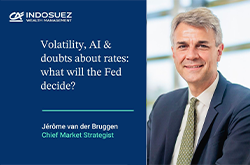Market acceleration against the backdrop of supportive economic policy

Market acceleration
Over the past three weeks markets have continued to push rapidly higher and this can be attributed to a number of new factors:
- The reinforcement of government support measures (alongside new support plans including USD 1.1 trillion in Japan, EUR 750 billion announced by the European Commission);
- Central banks have positively surprised markets by extending their asset purchase programmes more than anticipated; This has forced investors who had short positions to switch them and further fuel the market acceleration;
- The lifting of lockdown measures which for the moment are not showing a second wave of infections and the resumption of general containment measures that some feared. Sentiment and activity data as well as US employment figures are beginning to show a recovery in the economy from their April lows;
- Stabilisation of actions at the fundamental level (profit revisions) and at market level (volatility, technical indicators and sentiment indicators);
- Continued improvement of market liquidity conditions.
This explains why European stocks ended up leaving the consolidation zone in which they were locked into since the beginning of April until 20 May. It is fair to assume political uncertainty has previously represented a brake on the normalisation of European stocks valuations, unlike US stocks which had continued to progress throughout April and May.
Since 15 May, the Eurostoxx 50 has risen by around 20%, from 2’770 to 3’330 points (5 June at 10:30 am), outperforming US stocks over the past three weeks.
This is all the more paradoxical as simultaneously, on the fundamental level, results season showed a strong correction of expectations for 2020, which are now established at - 20% on US stocks and -28% on European stocks. However, we should note that the deterioration in consensus expectations took place mainly between the beginning of April and mid-May and that since then data has stabilised.
Strong support for economic policy in Europe
The European Central Bank (ECB) announced yesterday a EUR 600 billion extension of its Pandemic Emergency Purchase Programme (PEPP):
- The duration of the programme has been extended to at least mid-2021, with minimum reinvestment of maturities until mid-2022, offering real visibility and a safety net on sovereign spreads for several more quarters. This particularly supportive for peripherals’ spreads;
- The Asset Purchase Programme (APP) will see its pace maintained at EUR 20 billion per month, with no predefined end date. The ECB has stated that it would be maintained for as long as deemed necessary to accompany the accommodative effect of the policy rates. The maturities will be reinvested for an extended period of time beyond the first future rate hikes by the ECB (rates which will be maintained at their current levels as long as inflation remains below target);
- The ECB took the opportunity to lower its inflation forecasts to 0.8% in 2021 and 1.3% in 2022, thus indicating the sustainability of its accommodative action, the official inflation target still being out of reach;
- Christine Lagarde took advantage of the Q&A session to pass on some strong messages concerning the justification of the current purchasing programme.
These announcements had the effect of raising the euro beyond the 1.13 level against the dollar, compressing the yield on Italian 10-year debt by almost 20 basis points, and also allowing a further rebound in the equity markets as we approach the end of the week.
The European Commission recently announced an ambitious EUR 750 billion plan based on proposals from France and Germany, which added further support to the euro and helped reduce peripheral spreads allowing the equity market to continue to accelerate. However, the plan is scheduled to be validated at the upcoming European Summit in mid-June which leaves some uncertainty between then and now. Germany’s change in stance with regards to the question of financial transfers and community financing of this plan is a decisive and innovative element, which could convince the "frugal" countries of Northern Europe to accept the proposals.
Decrease in the level of perceived risk
The ECB and the European Commission joint action plan has reduced political risk in the Euro Zone and has enabled the euro to rise against the dollar, a movement in which the reduction in the transatlantic spread has already indicated. The coming weeks remain decisive, however, with the upcoming Summit of 18/19 June next and convincing the Member States hostile to the plan.
In equity markets, stabilisation of the landscape is taking place:
- The level of positive revisions is stabilising, pending the results of Q2;
- Market indicators are returning to neutral / positive territory (Bull / Bear indicator in particular);
- Volatility has continued to decrease, from more than 80 to less than 30 today;
- The flows send a mixed signal - little long only flows, little UCITS collection;
- A rotation sector in favour of value-style stocks and cyclical stocks, enabled by both a fall in political/sovereign risk in the Euro Zone, the successful lifting of lockdown measures and by a rise in energy prices.
In addition, the stress on emerging countries is being reduced with Asia and Latin America aided by the rise in the oil price, and the fall in political tensions in Brazil. In the short-term, the rising emerging currencies allows for risk of negative spiralling currencies and additional macroeconomic shocks to reduce. However, the risk on credit ratings remains present as evidenced by the downgrade of India's rating at the start of the week, leaving it only one notch above high-yield.
Finally, the level of liquidity stress observed in March has almost disappeared in the United States as evidenced by the level of difference between the 3M LIBOR and the Fed Funds. This seems to reflect a search for liquidity from investors as well as the significant liquidity support from the US Fed.
Markets Outlook
In the short-term, this positive trend can continue in June, calling into question the W scenario:
- Further compression of volatility which should lead to a further weighting of equities;
- Positive results from the European Summit can feed a return of flows into Europe;
- Lifting of lockdown measures which should allow an improvement of activity data for June;
- Level of liquidity in the portfolios which remains high for many investors;
- Value sphere which is still very undervalued despite the recent rebound;
- This trend also remains favourable to the euro in the short-term; it will be interesting to see whether the level of 1.1495 against the dollar reached on 9 March will be crossed, but it is quite possible that the downward trend in which the euro has been engaged since February 2018 is now over.
Factors that can encourage moderation, or at least not to aggressively strengthen positions, in this environment:
- Valuations have returned to high levels, particularly in the United States (price-to-earnings ratio of 22x), while expectations of results for 2021 seem too high to us. Q2 results may cause a form of return to reality of a still very gradual recovery;
- Political risk decreases in Europe but increases in the United States and geopolitical tensions with China could worsen before the elections;
- The technical indicators could soon play a role of resistance, after closing gaps and the return of the indices on the moving averages, and with a now important retracement of the correction and certain indicators which have already returned to European territory (RSI and put/call ratios in particular);
- Historically, sectoral rotations without significant fundamentals have been short-lived;
- A rapid rise of the euro could act as a brake on the appreciation of European equities.
To conclude, the months of May and June reflect a return of ambitious economic policy and of lifting of lockdown measures. Let us hope summer is not the return of political risk.
June 05, 2020




